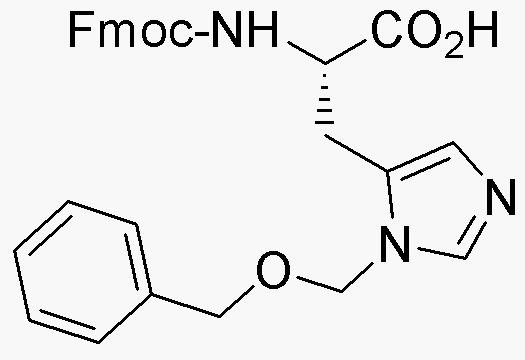Fmoc-His(3-Bom)-OH is widely utilized in research focused on:
- Peptide Synthesis: This compound serves as a key building block in the synthesis of peptides, particularly those containing histidine. Its protective Fmoc group allows for selective deprotection during the synthesis process, enhancing efficiency and yield.
- Drug Development: In pharmaceutical research, it is used to create histidine-containing peptides that can act as potential drug candidates, especially in targeting specific biological pathways or diseases.
- Bioconjugation: The compound facilitates the attachment of biomolecules, such as proteins or antibodies, to therapeutic agents, improving their efficacy and targeting capabilities in treatments like cancer therapy.
- Research in Biochemistry: It is employed in studies investigating enzyme activity and protein interactions, providing insights into metabolic pathways and cellular functions.
- Diagnostics: The compound can be utilized in the development of diagnostic tools, particularly in assays that require histidine for binding or detection purposes, enhancing the sensitivity and specificity of tests.
Información general
Propiedades
Seguridad y normativas
Aplicaciones
Fmoc-His(3-Bom)-OH is widely utilized in research focused on:
- Peptide Synthesis: This compound serves as a key building block in the synthesis of peptides, particularly those containing histidine. Its protective Fmoc group allows for selective deprotection during the synthesis process, enhancing efficiency and yield.
- Drug Development: In pharmaceutical research, it is used to create histidine-containing peptides that can act as potential drug candidates, especially in targeting specific biological pathways or diseases.
- Bioconjugation: The compound facilitates the attachment of biomolecules, such as proteins or antibodies, to therapeutic agents, improving their efficacy and targeting capabilities in treatments like cancer therapy.
- Research in Biochemistry: It is employed in studies investigating enzyme activity and protein interactions, providing insights into metabolic pathways and cellular functions.
- Diagnostics: The compound can be utilized in the development of diagnostic tools, particularly in assays that require histidine for binding or detection purposes, enhancing the sensitivity and specificity of tests.
Documentos
Hojas de datos de seguridad (HDS)
La SDS proporciona información de seguridad completa sobre la manipulación, el almacenamiento y la eliminación del producto.
Especificación del producto (PS)
La PS proporciona un desglose completo de las propiedades del producto, incluida la composición química, el estado físico, la pureza y los requisitos de almacenamiento. También detalla los rangos de calidad aceptables y las aplicaciones previstas del producto.
Certificados de análisis (COA)
Busque certificados de análisis (COA) ingresando el número de lote del producto. Los números de lote y de partida se pueden encontrar en la etiqueta de un producto después de las palabras "Lote" o "Lote".
Número de catálogo
Número de lote/lote
Certificados de origen (COO)
Este certificado de origen confirma el país en el que se fabricó el producto y también detalla los materiales y componentes utilizados en él y si se deriva de fuentes naturales, sintéticas u otras fuentes específicas. Este certificado puede ser necesario para cumplir con las normativas aduaneras, comerciales y regulatorias.
Número de catálogo
Número de lote/lote
Hojas de datos de seguridad (HDS)
La SDS proporciona información de seguridad completa sobre la manipulación, el almacenamiento y la eliminación del producto.
DownloadEspecificación del producto (PS)
La PS proporciona un desglose completo de las propiedades del producto, incluida la composición química, el estado físico, la pureza y los requisitos de almacenamiento. También detalla los rangos de calidad aceptables y las aplicaciones previstas del producto.
DownloadCertificados de análisis (COA)
Busque certificados de análisis (COA) ingresando el número de lote del producto. Los números de lote y de partida se pueden encontrar en la etiqueta de un producto después de las palabras "Lote" o "Lote".
Número de catálogo
Número de lote/lote
Certificados de origen (COO)
Este certificado de origen confirma el país en el que se fabricó el producto y también detalla los materiales y componentes utilizados en él y si se deriva de fuentes naturales, sintéticas u otras fuentes específicas. Este certificado puede ser necesario para cumplir con las normativas aduaneras, comerciales y regulatorias.


